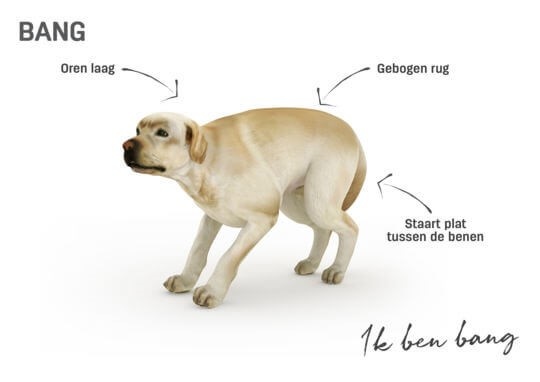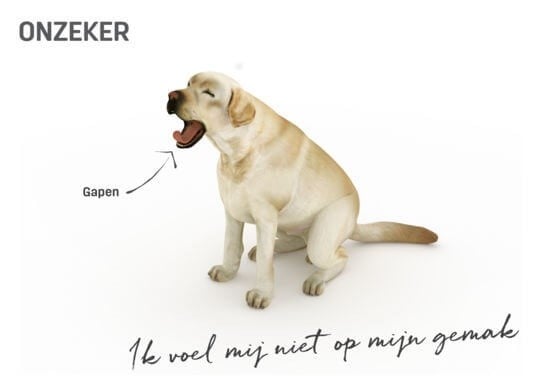- All products are added to your cart.
Fast delivery!
-
On weekdays, order before 14:00h and we will ship the same day!
-
Kwalitatief hoogwaardige producten.
-
Fair prices
-
Shipping to other countries depend on country
11 signs that your dog is stressed, depressed, or sad.
"Like humans, dogs have a rich inner life and are capable of experiencing a wide range of emotions, both positive and negative. Since dogs cannot speak, they communicate their feelings in other ways. If a dog is stressed, depressed, or sad, its behavior changes. As a dog owner, it is important to recognize these signals so that we can take action and alleviate these negative feelings in our dogs before they lead to serious problems. Prolonged or chronic stress can jeopardize a dog's overall health and well-being by weakening their immune system and causing behavioral issues.

What Causes Dogs to Be Stressed, Depressed, or Sad?
Feelings of stress, depression, and sadness are often caused by periods of change or unclear or inconsistent rules in a dog's life. Moving to a new home, the addition of a new family member such as a baby or a new pet, or the loss of an owner or companion can lead to feelings of anxiety and depression in a dog. A significant change in a dog's daily routine, such as an owner working longer hours or staying in a kennel or shelter for an extended period, can also trigger feelings of stress or depression.
Dogs can also become stressed or depressed if they do not have an outlet for normal dog behaviors such as running, fetching, sniffing, and digging.
Stress is also often caused by separation from an owner, loud noises, large or unfamiliar objects, or large crowds.
Individual dogs will react to the same stressor in different ways. According to research, the way a dog reacts is determined by environmental factors, conditioning, genetics, and the dog's neurological adaptation. Stress or anxiety may be appropriate in some situations, such as a dog becoming stressed and anxious when confronted with a wild animal, but harmful in others, such as a fear of people wearing hats.
The 11 Signs of Stress in Dogs
1. Reduced or absent appetite
Feelings of stress and anxiety can cause a dog to lose interest in food. If your dog, who once loved food, now barely shows interest in eating, it is important to pay close attention. Stress and anxiety may be responsible, but there are also many medical issues that can cause a reduced or absent appetite. Therefore, it is important to have your dog checked by a veterinarian to rule out any underlying medical conditions before assuming that stress is the culprit.
2. Ears pinned back
Your dog may pin its ears back or flatten them when stressed or anxious. This is not always evident in breeds with floppy ears.

3. Nose and lip licking, yawning, drooling
One of the subtler signs of stress and anxiety that is easily missed is nose and lip licking, yawning, and drooling. These signs should be interpreted in their context. A dog in a relaxed environment that drools and licks its lips when offered something tasty is likely not stressed, but if lip licking is accompanied by a change in body posture, flattened ears, or panting, the dog is likely experiencing stress and anxiety.
Medical problems such as dental issues or nausea can also lead to licking and drooling, so it is important to have your dog checked by a veterinarian if these signs persist.

4. Changes in body posture or position
A stressed or anxious dog may cower or adopt a crouched body posture with its tail tucked under. A stressed dog may also freeze or avert its gaze from the perceived threat.

5. Panting
Dogs pant when they are excited, hot, out of breath after exertion, or stressed. Panting due to stress often accompanies other signs of stress and anxiety.
6. Trembling and shaking
Intense emotions such as fear and worry can cause a dog to tremble and shake. Pain and illness can also cause trembling and shaking, so it is important to have your dog checked by a veterinarian if these symptoms persist after your dog has calmed down or been removed from a stressful situation.
7. Diarrhea
Stressful situations such as adoption, kennel stays, moving, or separation from the owner can trigger diarrhea.
According to research, the release of norepinephrine (the "fight or flight" hormone) affects a dog's gastrointestinal tract, resulting in an attack of diarrhea.
Usually, stress-related diarrhea is short-lived and resolves within a few days with a diet of easily digestible food, possibly combined with an appropriate probiotic such as Zoolac Propaste. Because diarrhea can have many causes, your dog should be examined by a veterinarian if the diarrhea becomes more intense or severe, if there is blood in it, if the diarrhea is accompanied by other signs of illness such as vomiting or a reduced appetite, or if the diarrhea does not improve within a day or two.
If your dog, who was once completely house-trained, starts urinating or defecating indoors, it may be a sign of stress. Some dogs may defecate indoors because they lose control when they are anxious. Indoor urination or defecation can also indicate a medical problem, such as a urinary tract infection, or fecal or urinary incontinence, so it is important to have your dog checked by a veterinarian to determine the cause. Remember that your dog does not urinate or defecate indoors out of "spite," so punishing your dog can exacerbate this behavior or lead to other behavioral problems.
8. Repetitive or compulsive behavior
Long periods of stress and anxiety can lead to compulsive behaviors that help the dog cope with stressors such as lack of exercise and isolation. A chronically stressed dog may, for example, repeatedly lick one or more limbs in an attempt to calm itself. Other compulsive behaviors include chasing or spinning the tail and, for example, licking the air.
Some of these behaviors may have an underlying medical cause, such as pain from osteoarthritis (arthritis) causing the dog to repeatedly lick a limb, so it is important to have your dog examined by a veterinarian if it starts to exhibit repetitive behavior.
Signs of Depression or Sadness in Dogs
It is common for dogs to be depressed or sad during periods of change, such as the loss of an owner or companion. However, many serious medical conditions can also cause your dog to feel sad or depressed. If your dog exhibits any of these symptoms, you should first have it examined by a veterinarian to rule out an underlying illness.
9. Reduced appetite
A dog's appetite may decrease or even disappear when it experiences feelings of sadness or depression. As mentioned earlier, your dog may also experience a change in appetite when it is stressed. In general, sadness and depression are different from stress and anxiety, so it is important to view these signs in their context. A change in appetite should always be taken seriously because it can be a sign of an underlying medical condition.
10. Low activity level
If a usually active dog becomes lethargic or spends more time sleeping, it may indicate that it is depressed. Conditions causing pain can also be responsible, such as arthritis in older dogs.
11. Withdrawal
If your dog loses interest in things it used to enjoy, such as walking or playing, it may be a sign of depression. Dogs that are depressed or sad may also withdraw and not interact with people and other animals in the same way as before. However, as mentioned earlier, withdrawal can also be a sign of an underlying illness.
What to Do If Your Dog Shows Signs of Stress, Depression, or Sadness:
In certain situations, feelings of stress and anxiety are entirely appropriate. In these cases, it should be sufficient to remove your dog from the stressful situation to alleviate its stress feelings. If your dog frequently or in inappropriate situations exhibits signs of stress or anxiety, it is important to take action. Early recognition and treatment are essential to prevent feelings of anxiety from escalating and causing behavioral problems.
The first step is to have your dog examined by a veterinarian to rule out medical causes for its behavior. If your dog is healthy, work with a veterinarian or reputable behaviorist to identify the triggers and apply the appropriate treatment method. Some dogs may need a combination of medication and behavioral modification.
All dogs, including those with negative emotions such as stress, depression, or sadness, benefit from a routine of sleeping, eating, exercise, and play. Providing regular daily opportunities for exercise and mental stimulation is also beneficial."
---
Bron tekst/afbeeldingen: Herken de lichaamstaal van je hond (adaptil.com)
Source image: Ivonne Wierink/shutterstock.com


